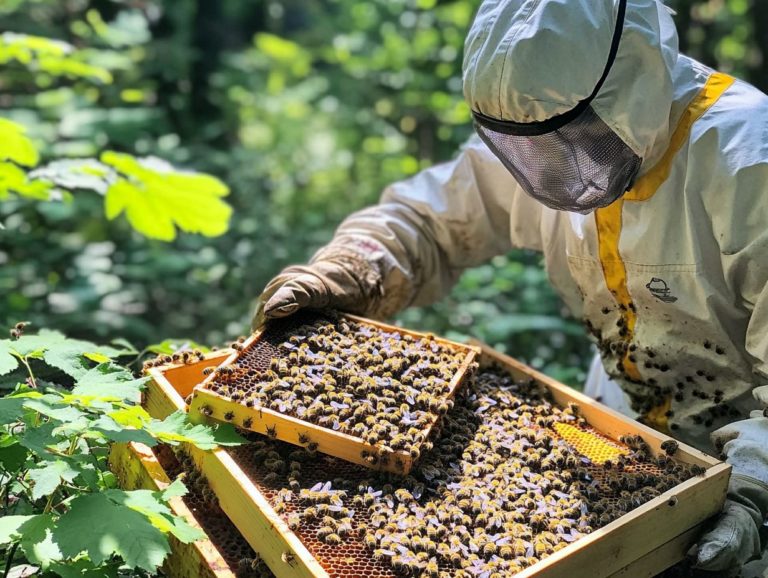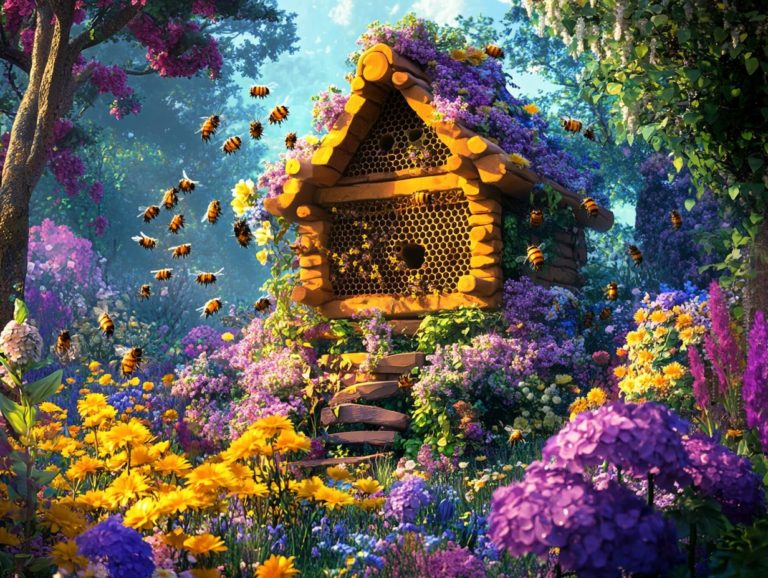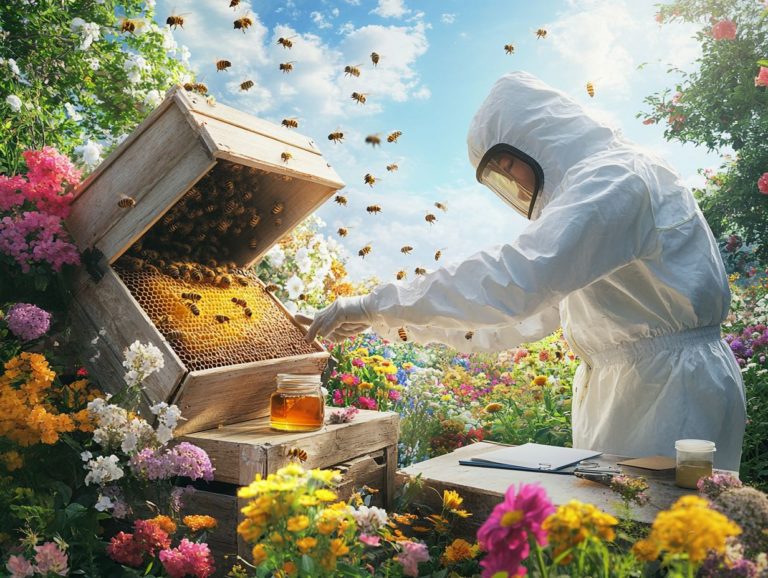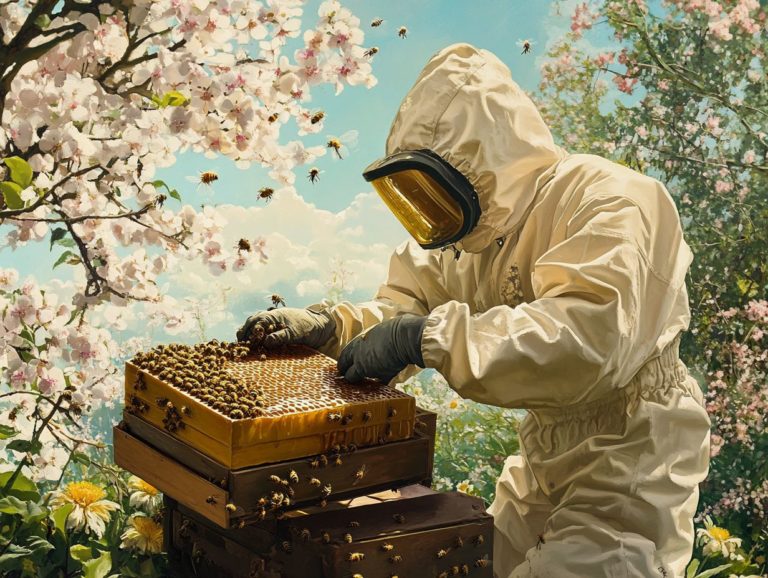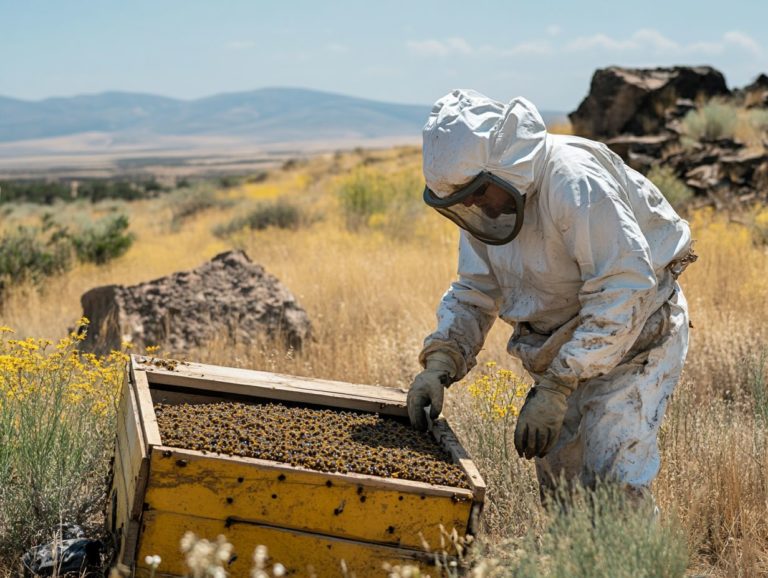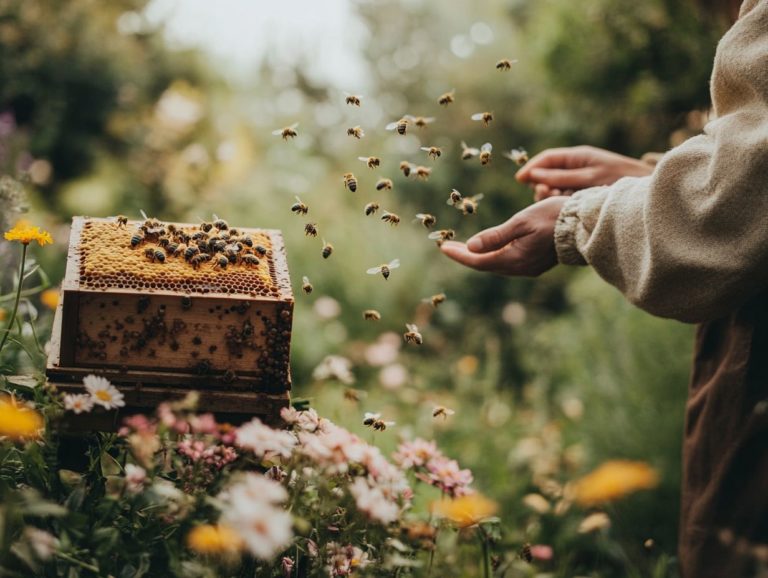Top Seasonal Hive Management Mistakes
Beekeeping is a rewarding yet demanding pursuit that requires both vigilance and expertise. Even seasoned beekeepers can find themselves making common missteps that could endanger the health of their honey bee colonies and disrupt the seasonal lifecycle.
From failing to assess the queen’s condition to neglecting proper ventilation, these oversights can lead to significant repercussions. This article will illuminate the top seasonal hive management mistakes, their effects on your bees, and the best practices for bee management and nurturing a flourishing hive.
Learn how to protect your bees, effectively manage your hive inspections, and elevate your beekeeping success to new heights!
Contents
- Key Takeaways:
- 1. Not Checking for Queen Health
- 2. Not Monitoring for Varroa Mites
- 3. Not Providing Adequate Ventilation
- 4. Not Providing Enough Space for Honey Production
- 5. Not Addressing Overcrowding
- 6. Not Rotating Frames Regularly
- 7. Not Providing Adequate Food Stores
- 8. Not Addressing Diseases and Pests Promptly
- 9. Not Preparing for Seasonal Changes
- 10. Not Consulting with Experienced Beekeepers
- How Can These Mistakes Affect the Health of the Hive?
- Frequently Asked Questions
- What are the top seasonal hive management mistakes to avoid?
- Why is checking your hives regularly important for hive management and bee management?
- How can I ensure that my bees have enough food and manage brood rearing effectively?
- What steps can I take to manage pests and diseases through integrated pest management?
- How does weather play a role in hive management?
- Why is queen health important for hive management and colony population?
Key Takeaways:
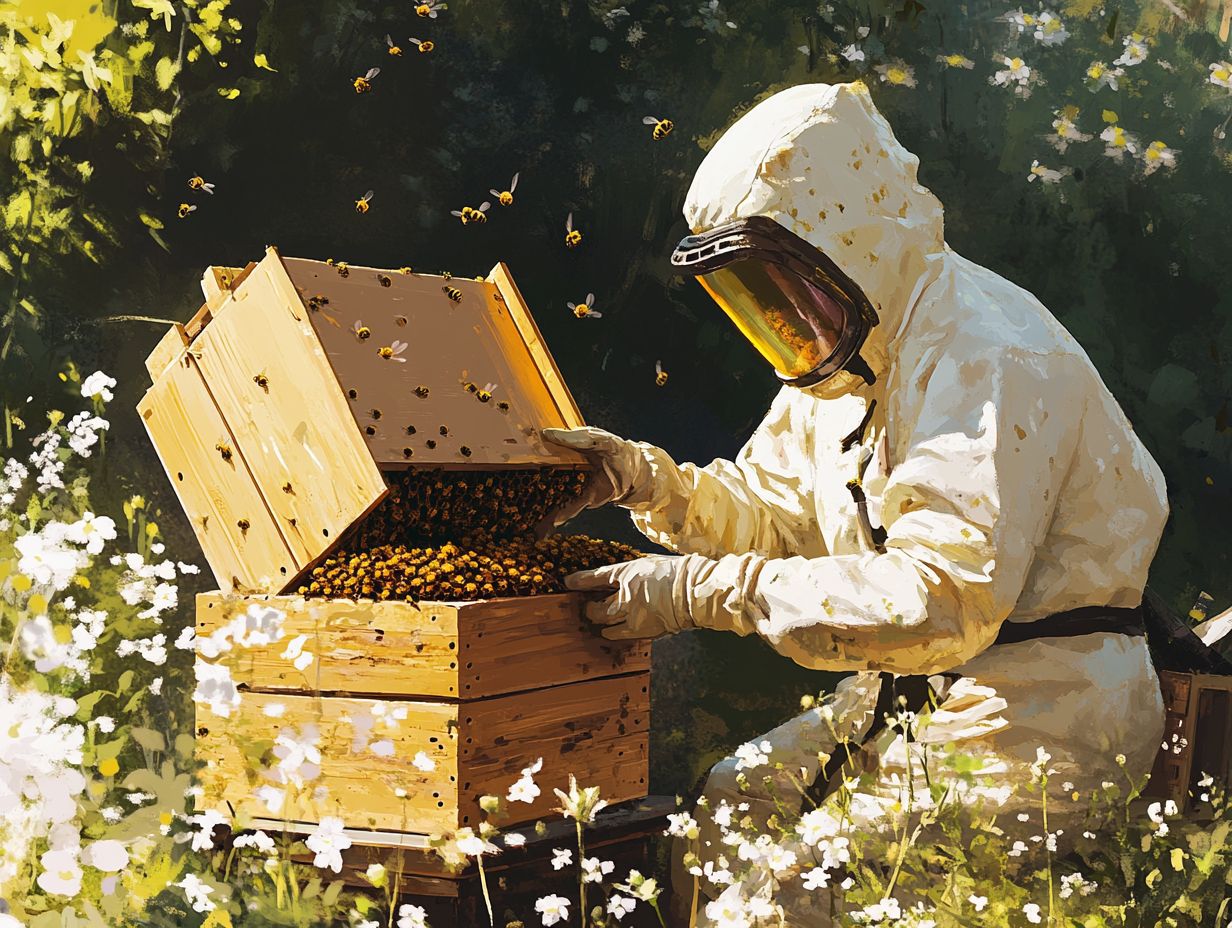
1. Not Checking for Queen Health
Checking for queen health is essential for effective bee management. The queen plays a vital role in maintaining the colony’s population and overall vitality.
Without a healthy queen, your hive may struggle to rear brood effectively. This can lead to diminished honey production and increased susceptibility to diseases such as European Foulbrood, Chalkbrood, and Varroa mites.
Regularly assessing the queen’s performance and her scent production that keeps the hive organized can significantly influence the colony’s productivity and resilience against pests. It’s crucial to ensure that the queen is laying eggs properly, as a failing queen can cause considerable losses in both colony strength and hive vitality.
Experts from the Center for Pollinator Research emphasize these practices. A thorough understanding of the signs of a failing queen like reduced egg production or insufficient scents that regulate colony behavior is essential.
Experts, including Maryann Frazier and Christina M. Grozinger, point out that monitoring these indicators can help you identify potential issues before they escalate. Christina M. Grozinger s research at the Grozinger Lab highlights the importance of queen pheromones in maintaining a cohesive hive structure. When these scents are lacking, worker bees may become disoriented or aggressive.
Therefore, assessing queen health not only contributes to robust brood rearing but also ensures a balanced and harmonious colony. This ultimately safeguards your hive’s future and productivity.
2. Not Monitoring for Varroa Mites
Neglecting to monitor for Varroa mites can spell disaster for the health and productivity of your honey bee colonies. These tiny yet formidable parasites weaken bees and transmit various pathogens.
This can result in brood diseases and a noticeable drop in honey production. If you overlook these pests, you could witness a swift decline in your hives, marked by abnormal brood patterns and a decrease in forager activity.
Recognizing the signs of infestation is absolutely essential. Symptoms may include bees exhibiting unusual behavior, such as disorientation, or an alarming presence of mites clinging to your bees.
To combat this threat, using Integrated Pest Management (IPM) strategies (a comprehensive approach that combines monitoring, prevention, and treatment) is crucial. Regular hive inspections allow you to spot early signs of infestation, assess the health of your bees, and take preventive measures.
These measures might include drone brood removal or applying treatments such as oxalic acid to ensure your colony remains thriving and resilient. Don t let these tiny pests ruin your hard work!
3. Not Providing Adequate Ventilation
Providing adequate ventilation is essential in your beekeeping practices to cultivate a healthy hive environment, particularly during the winter months when your winter bees are less active and more susceptible to moisture-related issues.
Without proper airflow, condensation can build up, creating a damp environment that fosters mold growth and diseases detrimental to the brood. To achieve optimal ventilation, consider incorporating sufficient entrance space and utilizing equipment such as screened bottom boards. It s crucial to monitor humidity levels within the hive and adjust ventilation as necessary.
Prepare for winter by offering supplemental feeding while keeping airflow in mind. This helps strike a balance between moisture and reduces the risk of condensation. This proactive approach not only protects your hive but also bolsters the overall health and productivity of your colony during the colder months. Institutions like Penn State recommend this approach.
4. Not Providing Enough Space for Honey Production
Inadequate space for honey production can significantly hinder a colony’s ability to thrive, ultimately leading to diminished honey stores and a stressed colony population that may even trigger swarming behavior.
To effectively assess and manage space within your hive, conduct regular inspections. Implementing supering, which involves adding extra boxes on top of the hive for bees to store honey, gives your bees more room to expand. This ensures your colony has sufficient capacity to store surplus honey during bountiful floral seasons when nectar and pollen are abundant.
Monitoring the connection between available nectar sources and overall honey production is vital. When nectar flow declines, timely interventions can prevent overcrowding and foster colony stability. By ensuring that your bees have ample space to work, you can greatly enhance their honey production and overall health.
5. Not Addressing Overcrowding
Overcrowding within a beehive can lead to a myriad of problems, presenting increased stress levels for the bees and a heightened risk of swarming, both of which can threaten the health of the colony and its honey production. Effective swarm prevention techniques are essential in such scenarios.
You might notice signs like bees clustering at the hive entrance or displaying increased aggression these clues can serve as important alerts to potential issues. Regular hive inspections are essential for you to assess population density and overall hive health. Schedule your hive inspections today!
To alleviate the pressure on the existing colony, consider providing additional space. This can be achieved by adding new supers or establishing new hives. Implementing swarm prevention strategies, such as creating splits or utilizing queen excluders, can further mitigate the tendency to swarm.
Engaging in queen rearing helps maintain healthy hive dynamics and minimizes the risk of overcrowding. Experts like Mehmet Ali D ke offer insights into efficient queen rearing practices.
6. Not Rotating Frames Regularly
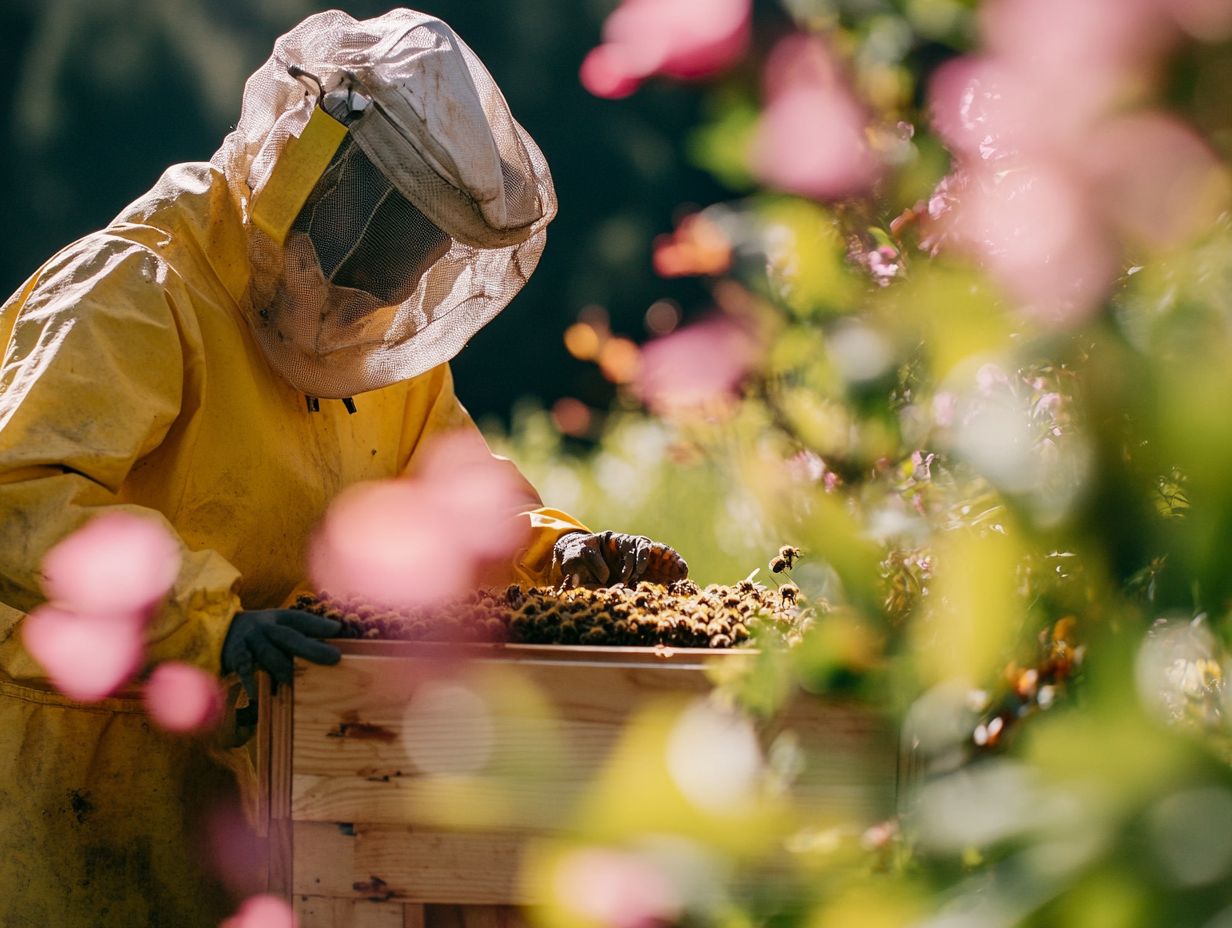
Neglecting to rotate your frames regularly can lead to a buildup of old comb, inviting brood diseases such as Sacbrood and Chalkbrood, compromising your hive management and honey production efficiency.
By adopting a consistent frame rotation strategy, you can significantly mitigate the risks of diseases like Chalkbrood and Sacbrood, which flourish in unsanitary conditions characterized by old comb. This approach not only cultivates a healthier environment for brood rearing but also enhances the overall vitality of your hive.
Effective frame management means periodically removing older frames and replacing them with fresh ones. This allows your bees to create new wax and provides a clean space for laying eggs. Maintaining fresh comb helps regulate hive temperature and reduces pest populations, ultimately fostering a thriving colony capable of withstanding various challenges. Regular frame rotation is vital for a thriving, successful colony!
7. Not Providing Adequate Food Stores
Neglecting to provide adequate food stores, especially before winter, can lead to starvation and serious declines in colony health. This makes winter preparation and supplemental feeding an essential practice for you as a beekeeper.
It’s vital for you to actively monitor honey stores throughout the changing seasons. Ensuring that your colonies have the resources they need to thrive is key. By assessing the amount of honey present during your hive inspections, you can determine whether additional feeding is necessary, especially as the colder months approach.
There are various methods for supplemental feeding, such as using sugar syrup or pollen substitutes. These methods help maintain your colony’s nutrition when natural resources begin to dwindle. Be mindful of signs of food scarcity, such as increased aggression or altered foraging patterns.
The balance between nectar pollen availability and colony health is crucial during seasonal transitions. Preparing for winter by ensuring that each hive is either full or supplemented can significantly enhance your colony s chances of survival as temperatures drop.
8. Not Addressing Diseases and Pests Promptly
Promptly addressing diseases and pests is essential for maintaining the health of your bee colonies. Any delays could lead to irreversible damage and substantial losses in honey production.
With the alarming rise of diseases like European Foulbrood, you must remain vigilant to protect your colonies. The impact of Varroa mites is particularly concerning; these parasites weaken your bees and spread viruses, intensifying the struggle for their survival.
Research from Mehmet Ali D ke and the Center for Pollinator Research highlights the importance of addressing these issues quickly. Implementing a mix of different methods to control pests is crucial in effectively managing these threats.
Using diagnostic techniques, such as looking at samples under a microscope and molecular methods, allows you to identify pathogens early. This gives you the best chance to act swiftly. It’s also important to use oxalic acid treatments when necessary.
For treatment options, tailor antibiotics for bacterial diseases and miticides for Varroa infestations carefully. This ensures the health of both your bees and the hive environment, protecting your hard work and investment. It s essential to monitor for brood diseases like Chalkbrood, Sacbrood, and European Foulbrood to maintain overall colony health.
9. Not Preparing for Seasonal Changes
Failing to prepare for seasonal changes can have severe repercussions for your honey bee colonies, especially as winter approaches. Effective management practices are vital for their survival.
As the colder months draw near, take proactive steps to ensure your hives are adequately protected and nourished. This includes providing supplemental feeding to bolster the bees’ energy reserves, as nectar sources tend to dwindle during this time.
Insulating your hives is another crucial task. It helps regulate the internal temperature and shields the colony from harsh elements. By monitoring the availability of floral resources throughout the seasons, you can anticipate periods of scarcity.
Adjust your feeding and resource management strategies accordingly. This proactive approach helps maintain a stable colony population and supports consistent honey production. Implementing these strategies is essential for maintaining colony strength and ensuring your bees emerge healthy and vibrant in the spring.
10. Not Consulting with Experienced Beekeepers
Not consulting with experienced beekeepers can significantly limit your understanding of effective bee management techniques and best practices for maintaining hive health and productivity.
Having a mentor can be an invaluable asset, offering you insights into the intricacies of hive inspections. This guidance helps you spot issues before they become serious problems, such as pests and diseases, that may arise.
Experienced mentors often share their hands-on knowledge about seasonal management strategies, queen rearing, and other essential beekeeping practices. These insights can dramatically enhance honey production and overall hive wellness.
Organizations like the American Beekeeping Federation and local beekeeping clubs are excellent resources, connecting you with seasoned professionals who can guide your journey.
Research institutions like Grozinger Lab and the Center for Pollinator Research provide opportunities for you to learn about the latest advancements in bee health and management, fostering a collaborative environment where you can share knowledge and techniques to ensure thriving bee populations.
Notable researchers such as Mehmet Ali D ke, Maryann Frazier, and Christina M Grozinger contribute extensively to this field.
How Can These Mistakes Affect the Health of the Hive?
Mistakes in your bee management can trigger a chain reaction of negative consequences for hive health. This can lead to declines in colony population, increased vulnerability to brood diseases, and ultimately, a drop in honey production.
For instance, if you neglect regular inspections, you might miss early warning signs of distress. This oversight can allow pests like Varroa mites harmful parasites that attack bees to thrive unchecked.
As these pests multiply, they weaken individual bees and compromise the overall structure of the colony, resulting in further population losses.
Similarly, if your feeding practices are off, you could inadvertently starve a colony during critical developmental phases. This would hinder brood rearing and stunt growth.
Each of these oversights doesn t exist in isolation; they compound and can jeopardize the vitality of your entire hive. Ensuring adequate honey stores is crucial during these times.
The reduction in bee numbers directly correlates to diminished wax production, lower honey yields, and even a decline in the colony’s resilience against environmental stressors.
What Are the Best Practices for Hive Management?
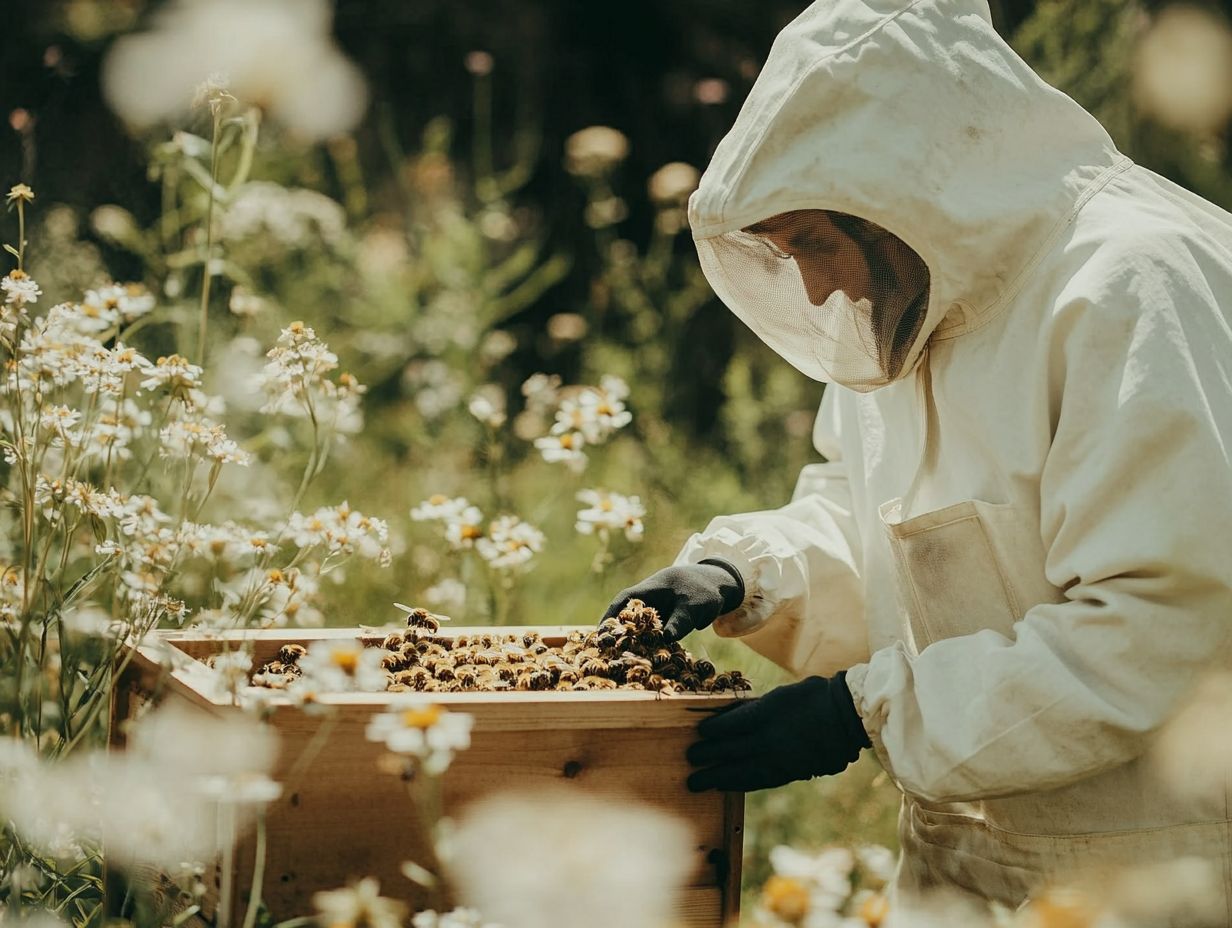
Implementing best practices for hive management is crucial to maintain optimal colony health and maximize honey production. Regular hive inspections are essential to keep your bees thriving!
Along with these essential activities, you should prioritize monitoring the queen’s health, ensuring she is efficiently laying eggs to sustain a robust population.
It’s equally important to maintain adequate food stores, especially as seasons change, providing your bees with the necessary resources to thrive.
Preventing overcrowding in the hive is vital to avoid swarming, which can significantly reduce honey production.
- Conduct regular hive inspections.
- Monitor the queen’s health.
- Maintain adequate food stores.
- Prevent overcrowding.
These practices not only enhance the resilience of your colony but also enable you to adapt your strategies in alignment with seasonal rhythms and local environmental conditions. Start implementing these practices today to ensure the health of your hive!
What Are the Signs of a Healthy Hive?
Identifying the signs of a healthy hive is essential for beekeepers striving for robust colony health. Look for indicators like strong brood rearing, plentiful nectar and pollen stores, and an active queen producing pheromones to keep the hive cohesive. Observing nurse bees diligently caring for the brood and winter bees preparing for colder months further confirms hive health.
A thriving hive showcases bees energetically foraging for resources, returning to the entrance with their legs heavy with pollen and nectar critical supplies for sustaining the colony. Healthy brood at various stages, from eggs to capped cells, indicates successful reproduction and development.
Regular hive inspections are crucial for monitoring these conditions. They allow you to catch early signs of distress or imbalance, such as a dip in foraging activity or potential disease indicators. By staying vigilant, you can prevent larger issues from arising and promote the longevity of your entire hive.
What Are the Common Misconceptions About Hive Management?
Common misconceptions about hive management can lead to ineffective practices, harming your colony’s population and reducing honey production. Informed beekeeping strategies are essential for success.
One prevalent myth is that bees only need your attention during the honey flow season. This belief can cause serious neglect during critical periods, such as pre-winter preparation and the crucial spring buildup. The idea that all bees are aggressive is a misleading generalization; many bee species, including honeybees, can actually be quite docile when handled with care.
Understanding that a well-maintained hive translates to healthier colonies is vital for your beekeeping journey. By debunking these myths, you can adopt proactive management techniques that enhance the well-being of your bees and significantly boost the overall productivity and sustainability of your apiary. Utilizing packages or nucleus colonies can be beneficial for maintaining hive strength.
How Can a Beekeeper Prevent These Mistakes?
Preventing common mistakes in bee management requires a proactive approach, which includes regular hive inspections, ongoing education, and a commitment to adapting practices based on the unique needs of your colony. Engaging with resources from Penn State adds a scholarly dimension to your knowledge base.
Establish a consistent inspection schedule, ideally every two weeks during the active seasons, to monitor potential issues and maintain the health of your hives. Staying informed about the latest pest management techniques and resources is crucial for effectively combating threats like Varroa mites. Joining local beekeeping associations or online forums provides invaluable insights and support.
Networking with seasoned beekeepers allows you to share experiences and learn from past challenges. This fosters a community that promotes the growth and success of bee populations, making your journey in beekeeping more effective and enriching.
What Are the Long-Term Effects of Neglecting Hive Management?
Neglecting hive management can lead to declining colony health, increased vulnerability to brood diseases, and a notable decrease in honey production over time.
These challenges often stem from inadequate monitoring of hive conditions, insufficient nutritional support, and a lack of preventative measures against pests and diseases. The cumulative impact becomes clear as colonies struggle to thrive, resulting in weakened bees less capable of foraging, reproducing, and ensuring their own survival. Ensuring the health of summer bees and winter bees through the seasons is critical.
As an aspiring beekeeper, you may not realize that sustainable practices, along with ongoing education about bee behaviors and their ecological needs, are crucial for nurturing strong, resilient colonies. When you make consistent hive management a priority, you unlock the full potential of your beekeeping journey!
By prioritizing consistent hive management and staying informed about best practices, you can enhance the long-term viability of your beekeeping efforts while fostering a healthier environment for all pollinators.
Start your journey to better beekeeping today!
Frequently Asked Questions
What are the top seasonal hive management mistakes to avoid?
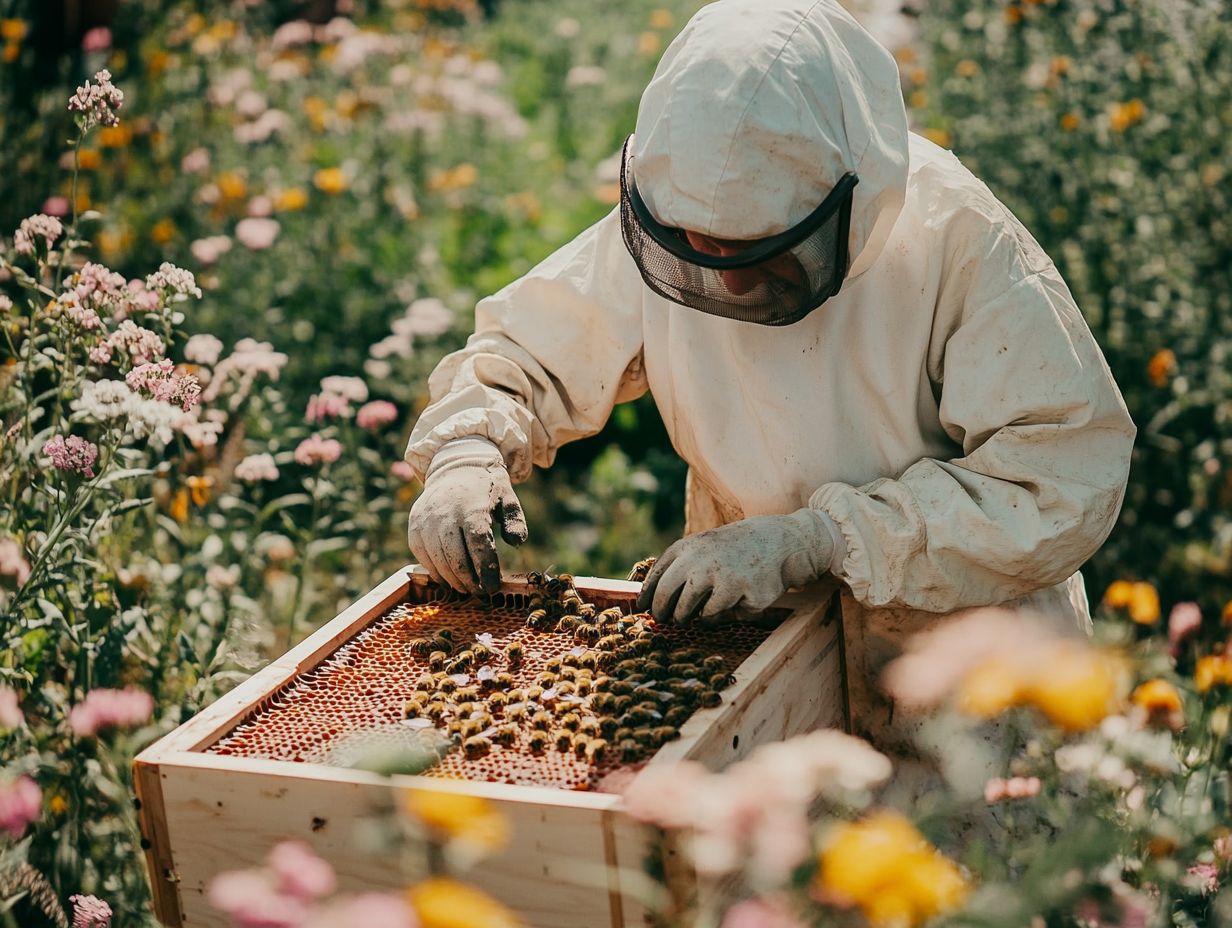
Avoid these seasonal hive management mistakes: not conducting regular inspections, not providing enough food for the bees, and not managing pests and diseases.
Also, consider the weather, monitor queen health, ensure proper ventilation, and understand the seasonal lifecycle of your colonies.
Why is checking your hives regularly important for hive management and bee management?
Regular hive inspections allow beekeepers to monitor the health of the hive, check for signs of pests or diseases, such as Varroa mites, and ensure that there is enough space for the bees to expand.
It also allows for early detection and prevention of potential problems, such as diseases affecting baby bees.
How can I ensure that my bees have enough food and manage brood rearing effectively?
Keep a close eye on your hive’s food stores to ensure your bees thrive! It’s important to provide supplemental feeding if necessary, which can include sugar water or pollen patties.
Additionally, beekeepers must also consider the availability of floral resources and whether extra food provided to the bees is necessary for the colony’s health and honey production.
What steps can I take to manage pests and diseases through integrated pest management?
Beekeepers should regularly check for signs of pests and diseases, such as mites, Chalkbrood, Sacbrood, and European Foulbrood, and take appropriate measures to control or treat them.
This may include using natural remedies, oxalic acid, or consulting a professional from the Center for Pollinator Research or Grozinger Lab at Penn State.
How does weather play a role in hive management?
The weather can have a significant impact on the health and productivity of a hive. Beekeepers should consider the seasonal lifecycle of bees when making management decisions, such as providing additional ventilation during hot weather or insulating the hive during cold weather.
Winter preparation is particularly important to ensure colony survival.
Why is queen health important for hive management and colony population?
The queen is the heart of the hive and responsible for laying eggs, so her health is crucial for the survival of the colony. Beekeepers should regularly check the queen for signs of illness or injury and requeen if necessary to maintain a strong and productive hive.
Queen health, pheromone production, and rearing new queens are essential for maintaining colony health and preventing issues such as swarm prevention.

